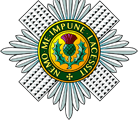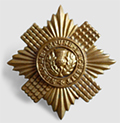The period from 1815 to 1854 involved no overseas service for the Scots Guards, some public order duties at home and little of interest other than that in two attempts on Queen Victoria’s life a Scots Guardsman was on the spot and closely involved in apprehending the perpetrator, though the first one was judged insane and may not even have had a loaded pistol. Meanwhile the clouds gathered over the Black Sea as Russia and Turkey were in dispute and when Russia invaded Turkish territory there was war. France and Britain sent a naval expedition to the Dardanelles by way of demonstration to induce Russia to back off, but it did not happen and both were soon on the Turkish side in the Crimean War. The objective of this was the destruction of the Russian fleet and naval base at Sebastopol. The 1st Scots Guards, with Grenadier and Coldstream battalions, was in the Guards Brigade that sailed early in 1854. By the time they arrived on the Black Sea coast the Russian invading troops had withdrawn back across their border, but an invasion of the Crimea was still on the table. Already there had been a lot of casualties from sickness among the troops waiting on the coast and those who were fit were very pleased to go when the British and French forces left for the Crimea on 7 September. Little was known about the Crimea, what was known was not of military value and it was late in the year for any military operation in a climate of that sort. Both armies started landing after a week at sea. Since it had been established before they left that most men were not fit enough to carry their packs these were left on board ship. There were very limited pack animals, almost no tents were landed and the plan was for the troops to be fed from the ships sailing level with them south toward Sebastopol. The French were nearest the sea as they had no cavalry to protect their flanks. Both armies had a fourteen mile march south without water till they reached the Bulganak stream. On 20 September they moved on across the plateau toward the River Alma. On the heights beyond they had their first sight of the enemy. To get at them involved first crossing the Alma through orchards, vineyards and buildings certain to break up the shape of military formations. The Guards Brigade were in the second wave of the attack and the Scots Guards in the middle arrived on the far side first, reformed and advanced. Owing to confusion and misdirection of the first wave in front of them they were almost immediately nearly overwhelmed by retreating men, but went on uphill and found themselves out on their own in the open and very vulnerable. It was a bad moment and next came what was heard as an order to retire that began to be acted on by the right hand companies, but was steadied and then the Grenadiers came up alongside. No one was further forward than the Scots Guards Colour Party. They stood fast. Ensign Robert Lindsay, carrying the Queen’s Colour, was awarded the first Army VC and Sergeant James McKechnie, Sergeant John Knox and Private William Reynolds also won the VC for the Alma. The Russians were driven back off the heights and withdrew towards Sebastopol. “ALMA” is another Battle Honour of great significance to the Scots Guards.
As the weather closed in for the winter it began to be very clear that, unlike the French, the British Army was very ill equipped and very ill supplied for it, but before the full privations took hold the Scots Guards were in another battle. In what was a good concept, but poorly coordinated, on 5 November a Russian force emerged from Sebastopol, now under siege by the British and French, while another approached from the north. Their aim was to capture the high ground British right hand positions. The attack began in the early morning in thick mist and quickly developed into a close quarter slogging match in which no one above company commander could make much sense of what was happening, while those doing the fighting could only see what was in front of them. The Guards Brigade came up quickly from their camp nearby, others also arrived and finally there were French reinforcements too. After several hours of very rugged and confused fighting the Russians were driven back downhill, both sides having suffered severely. This was “INKERMAN”, also a much venerated Battle Honour.
The suffering of the Army was then made worse still when a major storm battered the British fleet and supply ships in the port of Balaclava, those carrying the Army’s winter clothing all being sunk. Thick mud clogged the roads and camps, there was insufficient food, let alone clothing, and disease, notably cholera and dysentery, was rife. Meanwhile the siege of Sebastopol continued, so in addition to the unnecessary natural hardships there was also prolonged trench warfare. Come the spring of 1855 and conditions were much improved, though the siege went on, the casualty rates in the trenches a foretaste of what was coming sixty years later. Also, the Russians in Sebastopol had used their time well in fortifying it more strongly than before. Early in September Sergeant James Craig won the VC for going out in the trenches with another soldier to bring in an officer they thought had been wounded, but was dead. There had been unsuccessful assaults before on the Russian defence works and all of those on 8 September also failed except the French capture of the Malakoff. As this dominated all the others the Russians abandoned Sebastopol and escaped to the north. The winter was a stand off without incident and peace was signed in the spring, including a provision, repudiated by the Russians fifteen years later, that the Black Sea was to be demilitarised completely and that no warship was to enter it or go up the Dardanelles. The third Crimean War Battle Honour is “SEBASTOPOL”. Half of all Scots Guardsmen who served in the Crimea, whether having gone out at the start or arriving in reinforcements, were killed, wounded or invalided. A terrier of nondescript origin called Bob, acquired by the Battalion in 1853, went to and survived the Crimea, only to die under the wheels of a butcher’s cart when accompanying Queen’s Guard in 1860.


